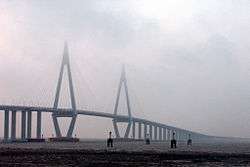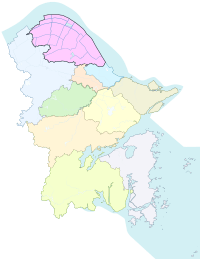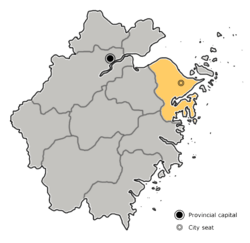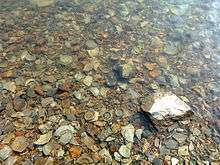Cixi, Zhejiang
Cixi (![]()
Cixi 慈溪市 Tzeki | |
|---|---|
 Hangzhou Bay Bridge | |
 Cixi City in Ningbo City | |
 Ningbo City in Zhejiang | |
| Country | People's Republic of China |
| Province | Zhejiang |
| Sub-provincial city | Ningbo |
| Area | |
| • County-level city | 1,360.63 km2 (525.34 sq mi) |
| • Urban | 1,360.63 km2 (525.34 sq mi) |
| • Metro | 2,861.43 km2 (1,104.80 sq mi) |
| Population (2010 census) | |
| • County-level city | 1,462,383[1] |
| • Urban | 1,462,383 |
| • Urban density | 1,100/km2 (2,800/sq mi) |
| • Metro | 2,473,042 |
| • Metro density | 860/km2 (2,200/sq mi) |
| Time zone | UTC+8 (China Standard) |
| Postal code | 315300 |
| Area code(s) | 330282 |
| Website | cixi.gov.cn |
| Cixi | |||||||||||||
|---|---|---|---|---|---|---|---|---|---|---|---|---|---|
| Chinese | 慈溪 | ||||||||||||
| Postal | Tzeki | ||||||||||||
| |||||||||||||
History
Cixi is a city with a rich culture and a long history. It was part of the state of Yue in the Spring and Autumn period (770-476 B.C.). The county was set up in the Qin Dynasty. At first it was called “Gouzhang” and has been using the name of “Cixi” since the Kaiyuan reign of the Tang Dynasty (738 A.D.).
Geography
Cixi City is located on the south of the economic circle of Yangtze River Delta, and is 60 km (37 mi) from Ningbo in the east, 148 km (92 mi) from Shanghai in the north and 138 km (86 mi) from Hangzhou in the west.
Administrative divisions
Subdistricts:[2]
- Baisha Road Subdistrict (白沙路街道), Gutang Subdistrict (古塘街道), Hushan Subdistrict (浒山街道), Kandun Subdistrict (坎墩街道), Zonghan Subdistrict (宗汉街道)
Towns:
- Andong (庵东镇), Changhe (长河镇), Chongshou (崇寿镇), Fuhai (附海镇), Guanhaiwei (观海卫镇), Henghe (横河镇), Kuangyan (匡堰镇), Longshan (龙山镇), Qiaotou (桥头镇), Shengshan (胜山镇), Tianyuan (天元镇), Xiaolin (逍林镇), Xinpu (新浦镇), Zhangqi (掌起镇), Zhouxiang (周巷镇)
Climate
Cixi has a subtropical monsoon climate, with an average annual temperature of 16℃.
Transportation
Cixi has an effective public transportation system. Highway connections are provided to all major cities, typical travel times are 1.5 hours or less by car, including access to the four major airports, Ningbo Lishe International Airport, Hangzhou Xiaoshan International Airport, Shanghai Hongqiao Airport, and Shanghai Pudong International Airport. Shanghai and Ningbo are also the closest sea ports.
Economy
Cixi is an important manufacturing city in northern Zhejiang province. The Hangzhou Bay New District is located in the city.
Population
Cixi is accelerating the construction of a mid-scale modern city, covering a total land area of 1,361 km2 (525 sq mi) with a population of 2.04 million, including 1.04 million registered permanent residents and one million temporary residents. Fifteen towns and five subdistricts are under the jurisdiction of Cixi City and there are 325 administrative villages including committees and communities.
Culture
The city houses many Yue Kiln Sites, which are widely regarded as one of the origin of Chinese porcelain.

Cixi has the tradition of advocating culture and emphasizing education, with several thousand years of historical relics and profound cultural background which cultivated three regional cultures, i.e. “celadon, reclamation and immigration”. Shanglin Lake celadon has been sold overseas as a “Maritime Silk Road” to the world, historical tideland reclamation area has become one of the areas with the most abundant land reserve resources in Zhejiang Province, and the immigration culture has several years of history.
Cixi was listed as the "demonstration base for community digital learning in the national city and countryside" by the Ministry of Education in 2010 and 2011.
Notable people
- Han Qide, medical scientist and Former President of the China Association for Science and Technology
- Han Zheng, member of Standing Committee of the CPC Central Committee Political Bureau
- Ing Chang-ki, Taiwan industrial magnate
- Lu Yongxiang, Academician and Former President of the Chinese Academy of Sciences
- Lu Zhangong, member of CPC 19th Central Committee
- Tan Jiazhen, founder of modern Chinese genetics
- Yang Xianjiang, educator
- Zhou Xinfang, Master of Beijing Opera
- Zhu Zuxiang, agricultural scientist
References
- "China: Zhèjiāng (Prefectures, Cities, Districts and Counties) - Population Statistics, Charts and Map". www.citypopulation.de.
- "宁波市-行政区划网 www.xzqh.org" (in Chinese). XZQH. Retrieved 2012-05-24.
External links
| Wikimedia Commons has media related to Cixi City. |

- The People's Government Cixi City official website